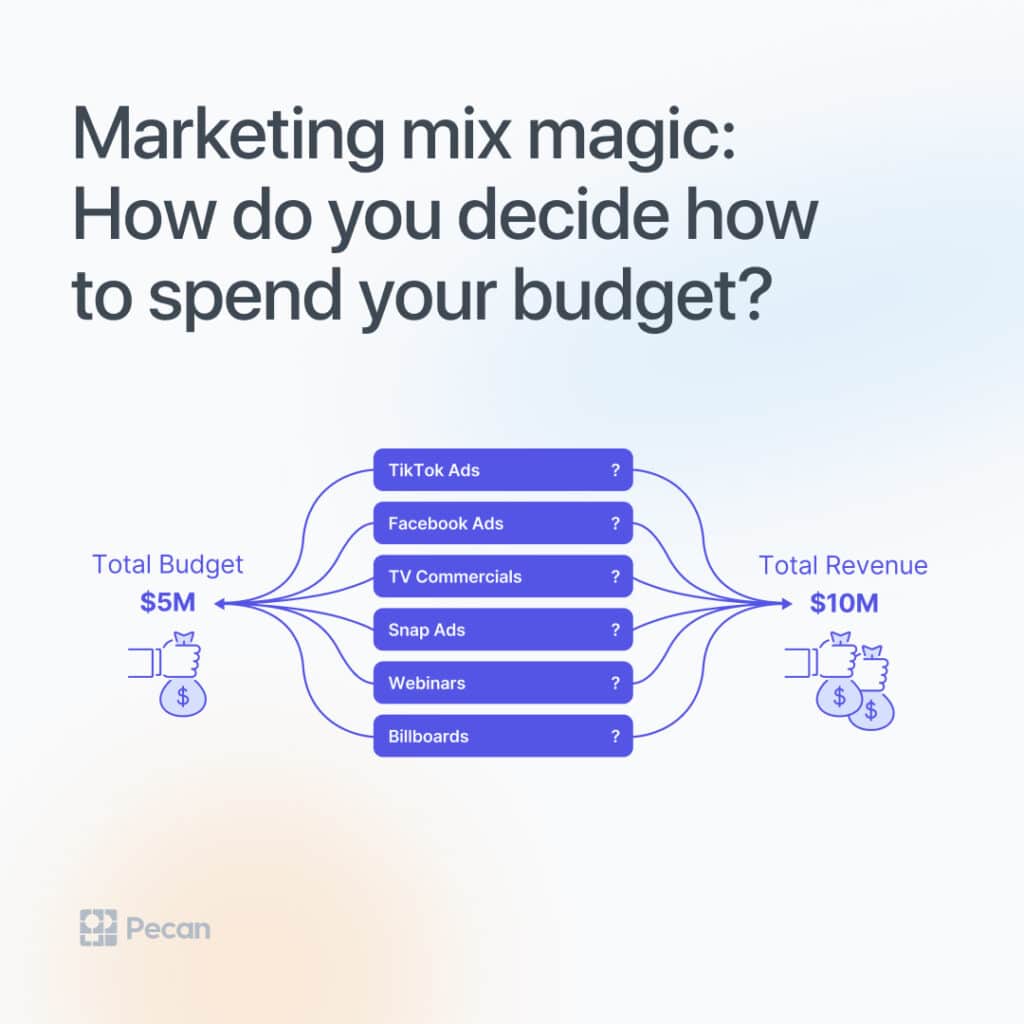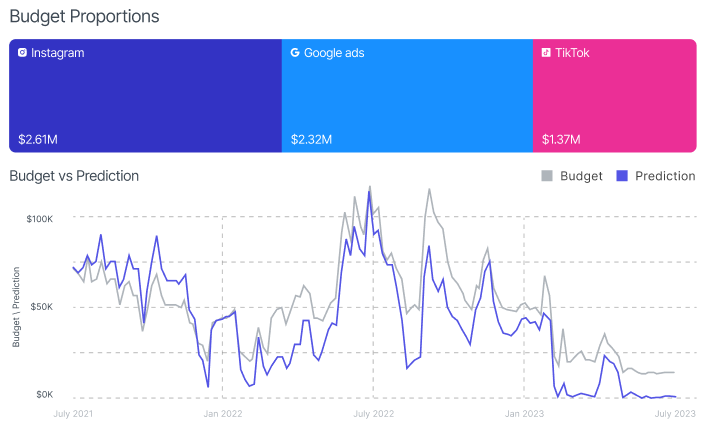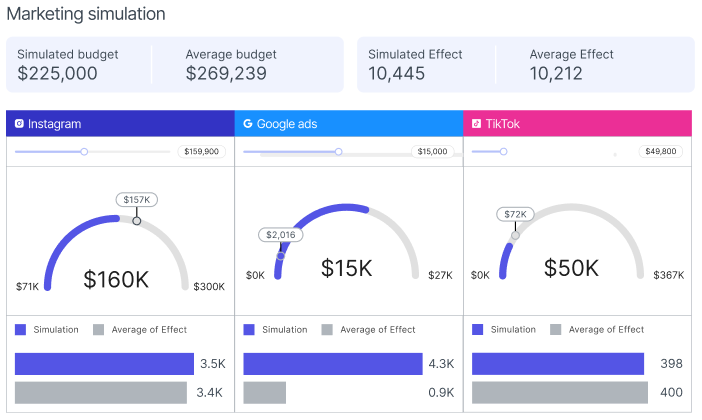In a nutshell:
- What is MMM? Marketing mix modeling (MMM) is a statistical analysis technique that helps marketers analyze the effectiveness of different marketing tactics and their impact on sales.
- MMM considers factors like product pricing, advertising spending, promotions, distribution, and external factors to make informed decisions on allocating marketing budgets.
- MMM offers insights into channel saturation, momentum, baseline, and ROI, helping companies identify areas with the highest return on investment.
- MMM is now more accessible with new software options and improved data and computational capabilities.
- MMM, combined with machine learning, provides a reliable and efficient solution for marketers to optimize their marketing strategies and achieve their goals.
Ever tried to bake cookies and left out the sugar? Or made a cocktail and forgotten a key ingredient? Your finished product probably didn’t taste quite right.
That might seem like a stretch as a metaphor for marketing, but it’s true. For marketing, as in baking and bartending, finding the right mix of ingredients is critical — or you won’t get the outcomes you want.
Fortunately, marketing mix modeling (MMM, sometimes also called media mix modeling) ensures you’ve got the essential ingredients in your marketing strategy, in the right amounts, to produce the desired results. Not too much, not too little: Determining how much of your ad spend to allocate to each marketing channel can be far more precise than ever before.
Let’s explore some marketing mix modeling basics to see if it’s the right fit for your team. (And after that intro, feel free to pause here if you need a snack or beverage – just come right back!)
What MMM helps solve: The art and science of allocating marketing budgets
Many marketers face a common obstacle: determining how to distribute and optimize their marketing budget to meet their objectives, even in this age of marketing AI. They all confront the same challenge of making the maximum return on investment with the most significant positive impact on sales.
In one recent survey, only 54% of marketers said they could confidently measure ROI across digital channels, and not necessarily for individual ones. But in another survey — this one by Nielsen — 71% of marketers polled said cross-media measurement is essential.
It's time to prioritize finding a measurement method that helps you calculate ROI with assurance and manage this vital task effectively.
-

- What MMM, or marketing mix modeling, helps marketers do
This challenge is universal and persistent, and it’s becoming increasingly difficult to solve. Since multiple channels emerged for communicating with consumers, marketers have grappled with prioritizing their investments. Today, the number of potential channels has grown significantly. Marketers must make informed decisions based on data that yield measurable outcomes. For example, does it make sense to pour more resources into TikTok, billboards, or television advertisements?
And not only are there more media channels to choose among, but they’re also constantly changing their policies and options for marketers. Most notably, as soon as marketers started to master the use of digital platforms’ user-level data for attribution and measurement, the data began disappearing — or soon will. Changes to iOS, SKAdNetwork, and the imminent loss of third-party cookies have introduced new challenges for commonly used marketing data measurement and attribution strategies.
This rapidly evolving setting is part of the reason for the renaissance of MMM, along with innovations that are adding technological twists to this legendary method. Whether you call it media mix modeling or marketing mix modeling, MMM has some remarkable new capabilities.
-

- What MMM provides: insights into marketing ROI and channel impact
What is MMM, or marketing mix modeling?
So what is MMM? It’s a statistical analysis technique that uses historical data that allows marketers to analyze the effectiveness of different marketing tactics and their impact on sales or other business goals. MMM considers a range of factors that influence sales, such as product pricing, advertising spending, promotions, distribution, and even external factors like the economy or competition.
By crunching these numbers, MMM reveals hidden patterns and granular insights that help businesses make informed decisions on allocating marketing budgets more effectively, improving marketing performance, understanding incremental sales, and achieving their goals.
Furthermore, MMM offers other valuable features. For instance, when allocating marketing budgets, MMM accounts for seasonality, which is crucial for many products and services. Moreover, MMM can incorporate external data like industry-wide sales figures, economic variables, and competitor activity.
-

- MMM helps marketers identify saturation points, or the amount of spend in a channel that returns no additional ROI.
MMM also provides insight into challenging-to-evaluate marketing aspects. One of those is channel saturation: the point where ROI stops increasing with additional spending. Another is momentum, also known as carryover or adstock, which refers to the last effects of long-term brand equity. Additionally, MMM can help you estimate baseline, the amount of sales or activity you'd achieve with no marketing efforts at all.
With this approach, companies can identify which areas of digital marketing and offline marketing spend have the highest ROI. Then, they can make better decisions about their ongoing marketing efforts.
What MMM is doing today: The technological renaissance
As you might have guessed by now, one of the significant advantages of MMM is that it isn’t affected by the nuanced mechanics of ad platforms and channels. Instead, it uses channel-level data to predict how much media spend to allocate to each channel to achieve the desired outcome (the dependent variable, such as revenue). MMM avoids the complications of obtaining and analyzing user-level data and the pitfalls of typical attribution methods.
But here’s the kicker: For about four decades, MMM was primarily reserved for big companies with deep pockets and access to cutting-edge data science technology. It required expensive specialists to build the models and the right computational tools, making it an impossible feat for smaller businesses.
That was then. With new software options and improved data and computational capabilities, MMM has become much more accessible. Marketing teams without access to extensive data resources and specialists can refresh models weekly or monthly, allowing for frequent budget optimization.
-

- Pecan’s MMM dashboards help marketers simulate outcomes and allocate budget efficiently.
What MMM + machine learning can do for your team
With its channel-level insights, MMM is an excellent complement to other measurement and planning techniques marketers use to understand the customer journey, such as attribution models. MMM offers a reliable guide to help achieve marketing goals when part of a fully developed measurement strategy.
As experts writing in the Harvard Business Review recently noted, "As privacy advances fundamentally change the digital ad measurement landscape, we recommend embracing MMM as a key part of the marketing analytics toolbox."
And, of course, let’s not forget about the new twists on traditional MMM powered by machine learning. Pecan has taken the best of the conventional approach to marketing mix modeling and integrated cutting-edge machine learning techniques to create a highly efficient, easy-to-use platform for marketers.
With our innovative solution, feature engineering, feature selection, and model optimization are all automated within a single MMM pipeline, saving valuable time and resources. Our approach offers a much faster, more iterative solution, perfect for the fast-paced world of modern marketing.
“In a very short time, Pecan’s MMM solution granted our team a new way of analyzing our marketing spend and its revenue contribution, while exposing opportunities for budget allocation and channel ROI optimization. We can now leverage both attribution data and MMM’s contribution to have a more holistic understanding of our marketing investments.”
— Evyatar Livny, VP Marketing Technologies, SciPlay
The limitations of marketing mix modeling
While MMM is powerful, there are some things MMM can't do: the limitations of this method of understanding marketing's impact.
- Data availability: Marketing mix modeling heavily relies on historical data, making it less effective for new products or markets with limited data.
- Lag in insights: MMM typically operates with a time lag due to data collection and processing, making it less responsive to rapidly changing market conditions. (New machine-learning powered MMM can reduce delays significantly, along with automated data flows and data preparation.)
- Complex implementation: Building and maintaining MMM models can be resource-intensive and require specialized expertise, making it less accessible for smaller businesses. New approaches, however, are making MMM much more feasible for businesses of all sizes (we have one suggestion you might explore).
Using marketing mix modeling to optimize marketing activities and ad spend
We've got a super compelling example of how MMM can save your business millions of dollars. Equipped with a billion-dollar marketing budget but facing an economic downturn, a major U.S. company sought to optimize its marketing spending across 20+ channels to enhance operating margins without sacrificing revenue.
They turned to Pecan's Marketing Mix Modeling (MMM). This solution allowed them to predict customer inquiries based on ad spending, utilizing four years of historical data to generate precise national and state-level predictions.
With MMM's simulation and optimization features, their marketers could experiment with different budget allocations and objectives in seconds, leading to impressive cost-cutting opportunities exceeding $100 million annually across different channels.
Moreover, considering customer lifetime value and cost per acquisition, the model's refinement promises an even more significant future impact, making MMM a valuable tool for data-driven planning and maximum business impact.
Common concerns about MMM (and why you shouldn't worry)
Is MMM biased toward traditional marketing channels, meaning it fails to account for the impact of digital marketing?
In examining pros and cons of MMM, some may argue that MMM does not adequately capture the dynamics of the evolving consumer and data landscape, potentially leading to skewed insights. However, it's essential to note that contemporary MMM methodologies have evolved to address these concerns.
Today's advanced MMM now integrates comprehensive data sources, encompassing both traditional and digital channels. By incorporating advanced analytics and machine learning techniques, MMM can effectively discern the unique contributions of each marketing channel, ensuring a more balanced and accurate representation of the overall marketing impact. In essence, modern MMM has adapted to the digital age — much like all of us.
Does MMM overlook customer behavior and preferences when it analyzes marketing success?
Some argue that MMM's focus on analyzing various marketing channels and their impact may not adequately account for customer engagement's nuanced and individualized aspects.
However, contemporary MMM methodologies address this concern. Advanced models now incorporate granular customer data from disparate sources, including behavioral insights and preferences, into the analysis. By leveraging sophisticated analytics and machine learning, MMM can discern patterns in customer behavior, helping businesses tailor their marketing strategies and ad spend to align more closely with individual preferences. Customer-centric approaches still reign for marketers who adopt machine learning-powered MMM.
Can MMM truly measure the long-term impact of marketing efforts on brand equity?
It's natural to be concerned that you fully capture the enduring influence of marketing activities on building and sustaining brand value over time.
Today's sophisticated MMM incorporates a more nuanced understanding of brand equity by considering both short-term and long-term indicators. With these modern approaches, MMM can provide insights into the lasting effects of marketing strategies on brand perception, customer experience, and loyalty. There's no need to fear your work's impact will go unrecognized: MMM has adapted to better measure the enduring effect of marketing on brand equity. It offers a comprehensive assessment of the actual value generated by marketing efforts.
Implementing MMM for your business
Thinking that MMM sounds like a good solution for your needs? If you're ready to implement it, there are some important steps to follow.
- Data collection: Gather comprehensive data on marketing expenditures, sales, and other relevant metrics. Be consistent in the channels and timeframes you select, and try to get accurate data.
- Variable selection: Identify the key variables and factors influencing your marketing outcomes. These could include channels, advertising spend, seasonality, and external factors like macroeconomic status and industry productivity.
- Model development and validation: Work with your data science team to construct and test an appropriate model using your historical data and chosen variables. Alternatively, use a solution like Pecan to handle this process. Pecan can partner with you to build and test an automatically updated model for faster time-to-market and ease of use.
- Optimization: Use the model to simulate different budget allocation scenarios. The simulations are a powerful tool to help you optimize marketing spending for maximum ROI.
- Continuous monitoring and refinement: It's critical to regularly update the model with new data. You'll also need to adjust it as market conditions change, ensuring its ongoing relevance and effectiveness.
The future-proof approach to marketing decision-making
With MMM’s top-down approach, you can be sure that your marketing plans are on the right track. It avoids the complexities and uncertainties of today’s digital ecosystem, making it a reliable and accurate tool for allocating marketing budgets. Knowing your resources are spent in the right places, you can focus on developing effective marketing campaigns and optimizing them once they launch.
Alternatively, you could use the time and energy to bake more cookies or make another cocktail. We won’t judge.
Excited about what MMM could do to boost your marketing ROI? Get in touch today to learn how our team of experts can help you get started fast.



